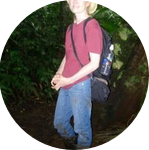About This Project
An ash-laden fossil leaf deposit in Central Washington assigned to the Ellensburg Flora (12 to 10 million years old) is part of a transported landslide block that cannot be correlated with certainty. Some of the leaves found are unusual and not typical of the Ellensburg Flora, raising the question of whether the site is assigned properly. We have something unique; dating the samples will tell us which direction our research should go.Ask the Scientists
Join The DiscussionWhat is the context of this research?
This is the western-most paleobotany site associated with the Grande Ronde Basalts of the Columbia River Basalt Group - a very significant event in Washington's geologic history. However, the transport of the fossil-bearing block confuses the story. The leaves are currently assigned to the Ellensburg Flora, whose age (12-10 million years) does not fit in with the age of the well-dated basalts that this site is associated with (17-15 million years). It is an important piece of the puzzle to understand where this site fits in to the overall story of the Columbia River Basalt Group.
The deposit is exposed at Hwy. 10 outside of Cle Elum, WA. The site is regularly visited by geology students, as it is very accessible and part of a spectacular series of lahars, ash deposits and lava flows that extend for miles. Leaf fossils frequently fall from the cliff face to the roadside, making collection an easy and popular activity. The best fossils were collected in the 1990s when the highway was widened, and are housed at the Denver Museum of Nature and Science, and the Burke Museum in Seattle. The leaves include Ginkgo, sweet gum, members of the birch and elm families, cattail, oak (leaves and acorns), maple, willow, and Platanus (plane tree). Grass and flowers have also been found, and the presence of Podocarpus is now suspected; no other conifers have been found, which is very unusual.
What is the significance of this project?
Ginkgo is especially significant, as it is thought to have disappeared from Washington around 12 to 14 million years ago. Dating this site may help pinpoint the date of this important event. Currently, Ellensburg Flora does not have Ginkgo. If the dating does put this site into the Ellensburg Flora, then Ginkgo will be a significant addition.
As well, the presence of Liquidambar (sweet gum) puts a minimum constraint on the precipitation in the area; this genus requires summer-wet conditions found in the cypress swamps of Georgia and the Mississippi Delta - very different from summer-dry, arid conditions of today's Central Washington!
What are the goals of the project?
Because the fossils are embedded in volcanic ash, they may be well-suited for Argon isotope geochronologic dating, which can provide precise information on the age of the site. Getting a good date will guide me to a proper interpretation of this site's place in the biogeographic and paleoclimatic history of Central Washington. Once I have the date of the site, whatever that date may be, I will be able to present my findings with confidence at the Botany Society of America July 2014 annual meeting. And of course, all backers will be acknowledged in the presentation and publication.
Budget
My funds will primarily be used for having the fossil-bearing layer dated using the Argon/Argon radiometric dating method. Oregon State University's Argon Geochronology Laboratory has offered their services to me. They have offered a fast turnaround time (3-6 months) for a single sample, which would allow me to have dating results back prior to the Botanical Society of America's annual meeting in July 2014, where I have been asked to present our findings. The quoted uncertainties for their method (0.100 -0.010 million years) is very appropriate for our needs.
Since the lab has decided to go with a slightly less expensive method than originally quoted at the beginning of this project, funds beyond the $750 dating fee will go toward fees for administering this project, then towards the expenses of attending the conference to present my findings.
Endorsed by
Meet the Team
Team Bio
I am a graduate student working on a Master's degree through a program offered by Miami University. In addition, I work in the Leopold Pollen and Seed Laboratory at the University of Washington Biology Department, where we are researching features of paleoclimatology and paleoecology.This project is the extension of an independent study project begun in 2011; once the site is dated, the results will be presented in Summer 2014 and published soon thereafter.
Additional Information
Smiley, C. J., 1963. The Ellensburg flora of Washington. University of California Publications in Geologic Science, v. 35, no. 3, p. 159-276.Project Backers
- 8Backers
- 141%Funded
- $1,150Total Donations
- $143.75Average Donation


